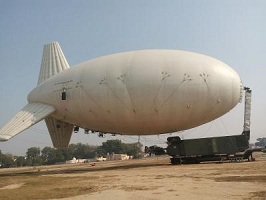Four years after Aerial Delivery Research and Development Establishment (ADRDE) indigenously developed Akashdeep, a medium-sized aerostat system for aerial surveillance, the premier laboratory under DRDO has now completed its trials of an improved version of the system which is ready to be deployed along the hostile Pakistan border. Once operational, India will join a select group of nations having developed such capabilities, including US, Germany, France and Japan. Nakshatra, as the new system is called, consists of the aerostat (an unmanned airship filled with helium gas) and the surveillance system.
After five months of rigorous tests in all weather conditions, the system is now ready to be handed over to the defence establishment users, including the Border Security Force and Army.
“Primarily developed for surveillance of sensitive borders such as the one with Pakistan, Nakshatra is a bigger variant of Akashdeep with bigger payload capacity fitted with night vision infrared cameras and high resolution HD cameras. It will last for 14 days in air before the unmanned airship is refilled with helium gas. In the earlier variant, there was no payload (aerial surveillance equipment or sensors) as such, though we had demonstrated its functionality with use of payload taken from other foreign agencies. In Nakshatra, we have additional payload capacity of 300kg for sensors and radars and can conduct surveillance from a height of up to 1km and across 360 degrees,” said a senior ADRDE official said.
“The system is a result of development of a number of high-end technologies in the field of aerodynamic design of balloon, fabrics, fabrication, hydraulic winch, electro-optic tether, high pressure helium cylinder manifold and so on and can be used during peacetime as well,” he added. The technology is a major step forward in the ‘Make in India’ drive, officials said, adding that several details were classified.








